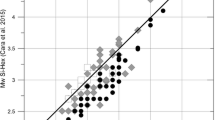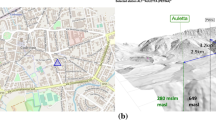Abstract
Probabilistic seismic hazard assessments are the basis of modern seismic design codes. To test fully a seismic hazard curve at the return periods of interest for engineering would require many thousands of years’ worth of ground-motion recordings. Because strong-motion networks are often only a few decades old (e.g. in mainland France the first accelerometric network dates from the mid-1990s), data from such sensors can be used to test hazard estimates only at very short return periods. In this article, several hundreds of years of macroseismic intensity observations for mainland France are interpolated using a robust kriging-with-a-trend technique to establish the earthquake history of every French mainland municipality. At 24 selected cities representative of the French seismic context, the number of exceedances of intensities IV, V and VI is determined over time windows considered complete. After converting these intensities to peak ground accelerations using the global conversion equation of Caprio et al. (Ground motion to intensity conversion equations (GMICEs): a global relationship and evaluation of regional dependency, Bulletin of the Seismological Society of America 105:1476–1490, 2015), these exceedances are compared with those predicted by the European Seismic Hazard Model 2013 (ESHM13). In half of the cities, the number of observed exceedances for low intensities (IV and V) is within the range of predictions of ESHM13. In the other half of the cities, the number of observed exceedances is higher than the predictions of ESHM13. For intensity VI, the match is closer, but the comparison is less meaningful due to a scarcity of data. According to this study, the ESHM13 underestimates hazard in roughly half of France, even when taking into account the uncertainty in the conversion from intensity to acceleration. However, these results are valid only for the acceleration range tested in this study (0.01 to 0.09 g).












Similar content being viewed by others
References
Ambraseys NN, Douglas J (2004) Magnitude calibration of north Indian earthquakes. Geophys J Int 159(1):165–206. https://doi.org/10.1111/j.1365-246X.2004.02323.x
Bakun WH, Scotti O (2006) Regional intensity attenuation models for France and the estimation of magnitude and location of historical earthquakes. Geophys J Int 164(3):596–610. https://doi.org/10.1111/j.1365-246X.2005.02808.x
Beauval C, Bard P-Y, Hainzl S, Guéguen P (2008) Can strong-motion observations be used to constrain probabilistic seismic hazard estimates? Bull Seismol Soc Am 98(2):509–520. https://doi.org/10.1785/0120070006
Beauval C (2011) On the use of observations for constraining probabilistic seismic hazard estimates-brief review of existing methods, Applications of Statistics and Probability in Civil Engineering, Faber, Kohler and Nishijima editors, London, 763-767 (ISBN 978-0-415-66986-3)
Beauval C, Yepes H, Palacios P, Segovia M, Alvarado A, Font Y, Aguilar J, Troncoso L, Vaca S (2013) An earthquake catalog for seismic hazard assessment in Ecuador. Bull Seismol Soc Am 103(2A):773–786. https://doi.org/10.1785/0120120270
Bossu R, Scotti O, Cotton F, Cushing M, Levret A (2000) Determination of geomechanical site effects in France from macroseismic intensities and reliability of macroseismic magnitude of historical events. Tectonophysics 324(1–2):81–110. https://doi.org/10.1016/S0040-1951(00)00112-8
BRGM/EDF/IRSN (2017) Base de données SISFRANCE – www.sisfrance.net, Last accessed April 2017
Burkhard M, Grunthal G (2009) Seismic source zone characterization for the seismic hazard assessment project PEGASOS by the expert group 2 (EG1b). Swiss J Geosci 102(1):149–188. https://doi.org/10.1007/s00015-009-1307-3
Caprio M, Tarigan B, Worden CB, Wiemer S, Wald DJ (2015) Ground motion to intensity conversion equations (GMICEs): a global relationship and evaluation of regional dependency. Bull Seismol Soc Am 105(3):1476–1490. https://doi.org/10.1785/0120140286
Council of Europe (1998) European macroseismic scale 1998 (EMS-98), Grünthal G (ed.), vol. 15, Centre Européen du Géodynamique et de Séismologie: Luxembourg
Douglas J (2017) Ground motion prediction equations 1964–2017, http://www.gmpe.org.uk. Last accessed October 2017
Jayaram N, Baker JW (2009) Correlation model for spatially distributed ground-motion intensities. Earthq Eng Struct Dyn 38(15):1687–1708. https://doi.org/10.1002/eqe.922
Lambert J (2004) Base de données SisFrance et SisFrance-Antilles, Sites internet, année 2004. Rapport final. Rapport BRGM/RP-53333-FR, 33 pp. In French
Mak S, Schorlemmer D (2016) A comparison between the forecast by the United States National Seismic Hazard Maps with recent ground-motion records. Bull Seismol Soc Am 106(4):1817–1831. https://doi.org/10.1785/0120150323
Manchuel K, Traversa P, Baumont D, Cara M, Nayman E, Durouchoux C (2017) The French seismic CATalogue (FCAT-17). Bull Earthq Eng. https://doi.org/10.1007/s10518-017-0236-1
Martin C, Combes P, Secanell R, Lignon G, Carbon D, Fioravanti A & Grellet B (2002) Révision du zonage sismique de la France: étude probabiliste, under the supervision of the Groupe d’Etude et de Proposition pour la Prévention du risque sismique en France and the Association Française du Génie Parasismique (in French), Geoter Report, GTR/MATE/0701–150
Medvedev SP, Sponheuer W, Karnik V (1967) Seismic intensity scale version 1964. Inst. Geody. Publ, Jena, 48 pp
Mucciarelli M, Albarello D, D’Amico V (2008) Comparison of probabilistic seismic hazard estimates in Italy. Bull Seismol Soc Am 98(6):2652–2664. https://doi.org/10.1785/0120080077
Musson RMW (2000) Intensity-based seismic risk assessment. Soil Dyn Earthq Eng 20(5–8):353–360. https://doi.org/10.1016/S0267-7261(00)00083-X
Musson RMW, Grünthal G, Stucchi M (2010) The comparison of macroseismic intensity scales. J Seismol 14(2):413–428. https://doi.org/10.1007/s10950-009-9172-0
Olea RA (1999) Geostatistics for engineers and earth scientists. Kluwer Academic Publishers, Dordrecht. https://doi.org/10.1007/978-1-4615-5001-3
Rey, J., Auclair, S., Douglas, J. and Lambert, J. (2013), Faisabilité et test d’une base de données des intensités macrosismiques historiques extrapolées pour les communes métropolitaines (phase 1), Final report. BRGM/RP-62941-FR, 75 p., 40 fig., 2 tabl., 1 ann. In French
Rey J, Auclair S and Monfort Climent D (2015a) Etablissement d’une base de données des intensités historiques extrapolées pour toutes les communes françaises (phase 2), Final report, BRGM/RP-64384-FR, 52 p., 11 fig., 4 tabl., 2 ann. In French
Rey J, Auclair S, Daniels P, Monfort Climent D and Raout S (2015b) Etablissement d’une base de données des intensités historiques extrapolées pour toutes les communes françaises (phase 3), Final report, BRGM/RP-65304-FR, 39 p., 2 ann. In French
Schlupp A (2016) ShakeMap fed by macroseismic data in France: feedbacks and contribution for improving SHA, AGU Fall Meeting, December 12–16, San Francisco
Scotti O, Baumont D, Quenet G, Levret A (2004) The French macroseismic database SISFRANCE: objectives, results and perspectives. Ann Geophys 47(2/3). https://doi.org/10.4401/ag-3323
Stirling M, Petersen M (2006) Comparison of the historical record of earthquake hazard with seismic-hazard models for New Zealand and the continental United States. Bull Seismol Soc Am 96(6):1978–1994. https://doi.org/10.1785/0120050176
Stucchi M, Rovida A, Gomez Capera AA, Alexandre P, Camelbeeck T, Demircioglu MB, Gasperini P, Kouskouna V, Musson RMW, Radulian M, Sesetyan K, Vilanova S, Baumont D, Bungum H, Fäh D, Lenhardt W, Makropoulos K, Martinez Solares JM, Scotti O, Živčić M, Albini P, Batllo J, Papaioannou C, Tatevossian R, Locati M, Meletti C, Viganò D, Giardini D (2013) The SHARE European Earthquake Catalogue (SHEEC) 1000–1899. J Seismol 17(2):523–544. https://doi.org/10.1007/s10950-012-9335-2
Tasan H, Beauval C, Helmstetter A, Sandikkaya A, Guéguen P (2014) Testing probabilistic seismic hazard estimates against accelerometric data in two countries: France and Turkey. Geophys J Int 198(3):1554–1571. https://doi.org/10.1093/gji/ggu191
Woessner J, Laurentiu D, Giardini D et al (2015) The 2013 European Seismic Hazard Model: key components and results. Bull Earthq Eng 13(12):3553–3596. https://doi.org/10.1007/s10518-015-9795-1
Acknowledgements
We thank Daniel Monfort-Climent, Philippe Daniels, Sindy Raout, Samuel Auclair, Pierre Gehl and, particularly, Jérôme Lambert for their contributions to the project on the creation of the database of interpolated intensities, which was funded by the French Ministry of the Environment. Early versions of this study were presented at the 35th General Assembly of the European Seismological Commission, the 9th National Colloquium of the French Association of Earthquake Engineering (AFPS2015) and the 4th International Colloquium on Historical Earthquakes and Macroseismology. We thank those people who commented on these presentations. Finally, we thank two anonymous reviewers for their comments on the first version of this article.
Author information
Authors and Affiliations
Corresponding author
Electronic supplementary material
ESM 1
(DOCX 2869 kb)
Rights and permissions
About this article
Cite this article
Rey, J., Beauval, C. & Douglas, J. Do French macroseismic intensity observations agree with expectations from the European Seismic Hazard Model 2013?. J Seismol 22, 589–604 (2018). https://doi.org/10.1007/s10950-017-9724-7
Received:
Accepted:
Published:
Issue Date:
DOI: https://doi.org/10.1007/s10950-017-9724-7




